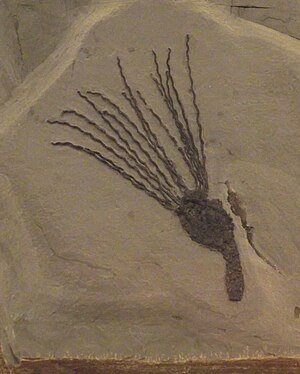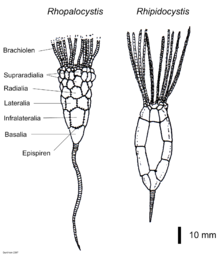Eocrinoidea
| Eocrinoidea | ||||||||||||
|---|---|---|---|---|---|---|---|---|---|---|---|---|

Gogia spiralis fossil |
||||||||||||
| Temporal occurrence | ||||||||||||
| Cambrian (Lower Cambrian) to Silurian | ||||||||||||
| 540 to 430 million years | ||||||||||||
| Locations | ||||||||||||
|
||||||||||||
| Systematics | ||||||||||||
|
||||||||||||
| Scientific name | ||||||||||||
| Eocrinoidea | ||||||||||||
| Jaekel , 1918 |
The eocrinoids ("primeval sea lilies") are an extinct class within the echinodermata tribe and are perhaps distantly related to the sea lilies and hair stars (class Crinoidea , sub-tribe Crinozoa) that are still alive today . In the systematics, the eocrinoids with about 30 genera are grouped together with the other extinct classes Cystoidea (pouch radiators), Blastoidea (bud radiators), Paracrinoidea and Parablastoidea in the sub-strain Blastozoa.
The eocrinoids are a very heterogeneous polyphyletic group that existed from the lower Cambrian to the Silurian . From them the cystoids developed in several separate lines. The eocrinoids are also considered to be the parent group of the paracrinoids and the parablastoids . It is unclear whether the similarity with the Crinoids is due to an actual relationship or whether it is a convergent development .
The eocrinoids - like the crinoids - have a spherical (also egg to pear-shaped) body capsule (theka) that is almost always seated on a stem or anchoring organ and consists of tablets and forms a rigid shell. The tablets of the Theka are partly completely unregulated, partly strictly regulated. At the borders of the tablets there are slit-shaped openings (Epispira) of a pore system presumably used for breathing. Unbranched brachioles (usually two-line) are attached to the theca, the theca is almost always attached to the sediment with a stem or anchoring organ.
Way of life
The eocrinoids fed by filtering edible particles with their brachioles from the flowing water and bringing them to the mouth. Almost all eocrinoids - like sea lilies - were permanently attached to the sea floor with a stalk ( sessile ).
literature
- Bernhard Ziegler: Introduction to Paleobiology Part 3 - ISBN 3-510-65179-0
- Treatise of Invertebrate Paleontology: Part S Echinodermata 1 - ISBN 0-8137-3020-1
Web links
- The Paleobiology Database Eocrinoidea
